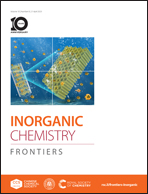Bimetallic phosphoselenide nanosheets as bifunctional catalysts for 5-hydroxymethylfurfural oxidation and hydrogen evolution†
Abstract
Selective electrocatalytic oxidation of biomass-derived 5-hydroxymethylfurfural (HMF) to valuable 2,5-furandicarboxylic acid (FDCA) with renewable electricity is highly desirable. However, such processes heavily depend on the development of high-performance electrocatalysts. Here, we describe how Mn-doped FePSe3 nanosheets can efficiently catalyze the conversion of HMF-to-FDCA under ambient conditions. The catalyst exhibits a faradaic efficiency of 92%, a corresponding yield rate of 218.5 μmol h−1 cm−2, and stable activity over 6 continuous cycles, all of which are comparable to the best reported results and exceed the values for pure FePSe3. In the meantime, the catalyst also displays excellent activity for alkaline hydrogen evolution with an overpotential of 102 mV at −10 mA cm−2. Therefore, in the following, the catalyst is further coupled as both the anode and cathode in a single electrolyzer, where hydrogen and FDCA can be generated simultaneously. Theoretical calculations indicate that Mn doping can promote HMF adsorption and reduce the hydrogen evolution barrier, thereby accelerating anodic and cathodic reactions. Our work reports a promising attempt at the electrosynthesis of organic chemicals.



 Please wait while we load your content...
Please wait while we load your content...